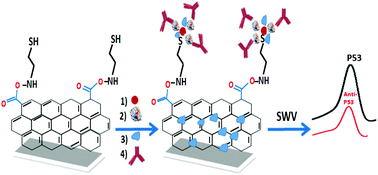Au nanoparticle decorated graphene nanosheets for electrochemical immunosensing of p53 antibodies for cancer prognosis†
Abstract
The accurate quantification of the level of p53 antibodies in serum is crucial for cancer prognosis. We report a novel and sensitive label-free immunosensor based on gold nanoparticles (Au NPs) self-assembled onto electrochemically reduced graphene oxide (ERGO) for the detection of p53 antibodies. An electrografted p-aminophenol organic layer was used to immobilize graphene oxide (GO) onto the surface of screen printed carbon electrodes (SPCE). The Au NP/ERGO hybrid interface provides a large surface area for the effective immobilization of p53 antigens, as well as it ascertains the bioactivity and stability of immobilized p53 antigens. Scanning electron microscope, Raman and X-ray photoelectron spectroscopies were used to monitor the sensor fabrication and cyclic voltammetry was used to quantify the extent of Au NPs’ surface coverage by p53 antigens. Square wave voltammetry (SWV) of a [Fe(CN)6]3−/4− couple was employed to investigate the immunosensor fabrication and to monitor the binding events between p53 antigens and p53 antibodies. Under optimized experimental conditions, the biosensor displayed good sensitivity and specificity. The p53 antibodies were detected in a concentration as low as 0.088 pg mL−1 with a linear range from 0.1 pg mL−1 to 10 ng mL−1. The high sensitivity of the immunosensor may derive from the high loading of p53 antibodies on Au NPs which increases the number of binding events.

- This article is part of the themed collection: Carbon and graphene in analytical science

 Please wait while we load your content...
Please wait while we load your content...